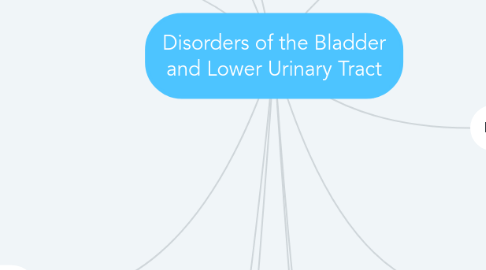
1. Three Main Levels of Neurologic Control of Bladder Function
1.1. Spinal cord reflex centers
1.1.1. Sacral (S1 through S4) and thoracolumbar (T11 through L2)
1.2. Micturition center in the pons
1.3. Cortical and subcortical centers
2. Storage and Emptying of Urine
2.1. Involves involuntary (autonomic nervous system) and voluntary control (somatic nervous system)
2.1.1. The parasympathetic nervous system promotes bladder emptying.
2.1.2. The sympathetic nervous system promotes bladder filling.
2.2. Striated muscles in the external sphincter and pelvic floor provide for voluntary control of urine.
3. ANS Drugs
3.1. Nicotinic Receptors
3.1.1. Sympathetic neurons
3.1.2. Increase bladder storage
3.2. Muscarinic Receptors
3.2.1. Inhibit sympathetic neurons
4. Detrusor muscle weakness results in decreased void pressure and therefore greater volume left in the bladder
5. Common Causes of Neurogenic Bladder
5.1. Stroke and advanced age Parkinson disease Spinal cord injury Injury to the sacral cord or spinal roots Radical pelvic surgery Diabetic neuropathies Multiple sclerosis
5.2. Neurogenic Bladder Disorders
5.2.1. Spastic Bladder Dysfunction
5.2.1.1. Failure to store urine
5.2.1.2. Neurologic lesions above level of the sacral cord allow neurons in the micturition center to function reflexively without control from the CNS centers.
5.2.2. Flaccid Bladder Dysfunction
5.2.2.1. Bladder emptying is impaired
5.2.2.2. Neurologic disorders affect motor neurons in the sacral cord or peripheral nerves that control detrusor muscle contraction and bladder emptying
5.3. Goals of Treatment for Neurogenic Bladder Disorders
5.3.1. Prevent bladder overdistention Prevent urinary tract infections Prevent potentially life-threatening renal damage Reduce the undesirable social and psychological effects of the disorder
5.3.2. Treatments for Neurogenic Bladder Disorders
5.3.2.1. Catheterization Bladder retraining Pharmacologic manipulation Surgical procedures
6. Bladder Cancer
6.1. Signs
6.1.1. Increased frequency
6.1.2. Urgency
6.1.3. Dysuria
6.1.4. Hematuria
6.2. Cancerous Lesion Types
6.2.1. Superficial Invasive
6.3. Diagnostic Measures for Cancer of the Bladder:
6.3.1. Cytologic studies
6.3.2. Excretory urography
6.3.3. Cystoscopy
6.3.4. Biopsy
6.3.5. Ultrasonography
6.3.6. CT scans
6.3.7. MRI
6.4. Treatment Methods for Bladder Cancer
6.4.1. Treatment methods depend on
6.4.1.1. The cytologic grade of the tumor
6.4.1.2. The lesion’s degree of invasiveness
6.4.2. Methods include
6.4.2.1. Surgical removal of the tumor
6.4.2.2. Radiation therapy
6.4.2.3. Chemotherapy
7. Structure of the Bladder:
7.1. Parts:
7.1.1. Fundus (body) Neck (posterior urethra)
7.2. Urine:
7.2.1. passes from the kidneys to the bladder through the ureters
7.3. Ureters:
7.3.1. enter the bladder bilaterally at a location toward its base and close to the urethra
7.4. Trigone:
7.4.1. the triangular area bounded by the ureters and the urethra
8. Four Layers of the Bladder
8.1. Outer Serosal Layer
8.1.1. Covers upper surface; is continuous with the peritoneum
8.2. Detrusor Muscle
8.2.1. A network of smooth muscle fibers
8.3. Submucosal Layer
8.3.1. Loose connective tissue
8.4. Inner Mucosal Lining
8.4.1. Transitional epithelium
9. Urine Tests and Studies
9.1. Laboratory and Radiographic Studies
9.1.1. Urine tests and x-rays
9.2. Urodynamic Studies
9.2.1. Uroflowmetry Cystometry Urethral pressure profile Sphincter electromyography
9.2.2. Ultrasound bladder scan
10. Signs of Outflow Obstruction and Urine Retention:
10.1. Bladder distention Hesitancy Straining when initiating urination Small and weak stream Frequency Feeling of incomplete bladder emptying Overflow incontinence
11. Incontinence
11.1. Types of Incontinence
11.1.1. Stress Incontinence
11.1.1.1. Involuntary loss of urine during coughing, laughing, sneezing, or lifting
11.1.1.2. Increases intra-abdominal pressure
11.1.2. Urge Incontinence
11.1.2.1. Involuntary loss of urine associated with a strong desire to void (urgency)
11.1.3. Overflow Incontinence
11.1.3.1. Involuntary loss of urine that occurs when intravesicular pressure exceeds the maximal urethral pressure because of bladder distention in the absence of detrusor activity
11.1.4. Mixed Incontinence
11.1.4.1. Combination of stress and urge incontinence
11.2. Treatment Options for Incontinence
11.2.1. Management depends on the type of incontinence, accompanying health problems, and the person’s age.
11.2.2. Behavioral and pharmacological measures
11.2.3. Exercises to strengthen the pelvic muscles
11.2.4. Surgical correction
11.2.5. Noncatheter devices to obstruct urine flow or collect urine
11.2.6. Indwelling catheters
11.2.7. Self-catheterization
